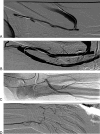Distal revascularization and interval ligation: a primer for the vascular and interventional radiologist
- PMID: 21326503
- PMCID: PMC3036428
- DOI: 10.1055/s-0029-1222456
Distal revascularization and interval ligation: a primer for the vascular and interventional radiologist
Abstract
Dialysis-associated steal syndrome is a clinically significant complication associated with the creation of dialysis grafts or fistulae. The distal revascularization and interval ligation (DRIL) procedure is a surgical procedure, which has been used to treat patients with hand ischemia secondary to arterial "steal" from dialysis accesses. This article will review the dialysis-associated steal syndrome and the history, anatomy, and clinical results of the DRIL procedure.
Keywords: DRIL; arterial steal; dialysis; distal revascularization and interval ligation; hand ischemia.
Figures




Similar articles
-
Distal Revascularization and Interval Ligation for the Management of Dialysis Access Steal Syndrome.Ann Vasc Surg. 2021 Jul;74:29-35. doi: 10.1016/j.avsg.2021.01.102. Epub 2021 Apr 2. Ann Vasc Surg. 2021. PMID: 33819594
-
Hemodialysis-related steal syndrome: predictive factors and response to treatment with the distal revascularization-interval ligation procedure.Ann Vasc Surg. 2008 Mar;22(2):210-4. doi: 10.1016/j.avsg.2007.12.005. Ann Vasc Surg. 2008. PMID: 18346574
-
Using distal revascularization with interval ligation as the primary treatment of hand ischemia after dialysis access creation.J Vasc Surg. 2013 Apr;57(4):1073-8; discussion 1078. doi: 10.1016/j.jvs.2012.10.085. Epub 2013 Jan 29. J Vasc Surg. 2013. PMID: 23375137
-
Modified distal revascularization with interval ligation procedure for steal syndrome after arteriovenous fistula creation for hemodialysis access.Vascular. 2007 Jul-Aug;15(4):226-30. doi: 10.2310/6670.2007.00047. Vascular. 2007. PMID: 17714640 Review.
-
Ischemic steal syndrome: a case series and review of current management.Curr Surg. 2006 Mar-Apr;63(2):130-5. doi: 10.1016/j.cursur.2005.04.017. Curr Surg. 2006. PMID: 16520116 Review.
Cited by
-
Most important chronic complications of arteriovenous fistulas for hemodialysis.Med Princ Pract. 2013;22(3):220-8. doi: 10.1159/000343669. Epub 2012 Nov 2. Med Princ Pract. 2013. PMID: 23128647 Free PMC article. Review.
-
Distal ischemia induced by vascular access for hemodialysis - a case report.Hippokratia. 2012 Oct;16(4):375-7. Hippokratia. 2012. PMID: 23935322 Free PMC article.
-
Arteriovenous fistulas and digital hypoperfusion ischemic syndrome in patients on hemodialysis.World J Nephrol. 2013 May 6;2(2):26-30. doi: 10.5527/wjn.v2.i2.26. World J Nephrol. 2013. PMID: 24175262 Free PMC article.
-
Graft Inclusion Technique: A New Flow Reduction Procedure for High Flow Arteriovenous Fistulae.Ann Vasc Dis. 2018 Jun 25;11(2):202-209. doi: 10.3400/avd.oa.17-00132. Ann Vasc Dis. 2018. PMID: 30116412 Free PMC article.
-
Dialysis-associated steal syndrome as a rare complication of arteriovenous fistula angioplasty.J Surg Case Rep. 2024 Oct 10;2024(10):rjae645. doi: 10.1093/jscr/rjae645. eCollection 2024 Oct. J Surg Case Rep. 2024. PMID: 39399637 Free PMC article.
References
-
- Huber T S, Brown M P, Seeger J M, Lee W A. Midterm outcome after the distal revascularization and interval ligation (DRIL) procedure. J Vasc Surg. 2008;48(4):926–932. discussion 932–933. - PubMed
-
- Lazarides M K, Staramos D N, Panagopoulos G N, et al. Indications for surgical treatment of angioaccess-induced arterial “steal”. J Am Coll Surg. 1998;187(4):422–426. - PubMed
-
- Morsy A H, Kulbaski M, Chen C, Isiklar H, Lumsden A B. Incidence and characteristics of patients with hand ischemia after a hemodialysis access procedure. J Surg Res. 1998;74(1):8–10. - PubMed
-
- Papasavas P K, Reifsnyder T, Birdas T J, Caushaj P F, Leers S. Prediction of arteriovenous access steal syndrome utilizing digital pressure measurements. Vasc Endovascular Surg. 2003;37(3):179–184. - PubMed
-
- Suding P N, Wilson S E. Strategies for management of ischemic steal syndrome. Semin Vasc Surg. 2007;20(3):184–188. - PubMed

